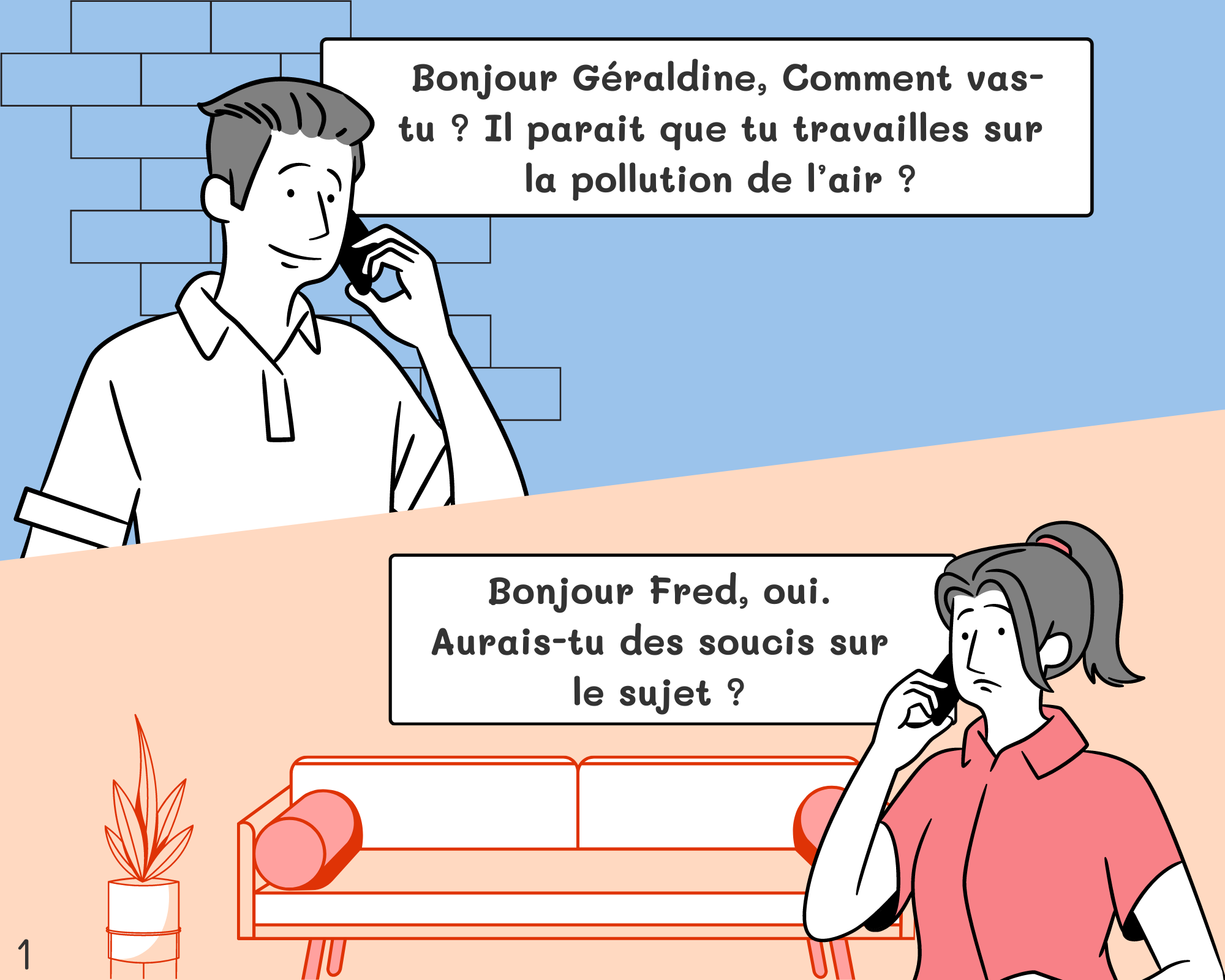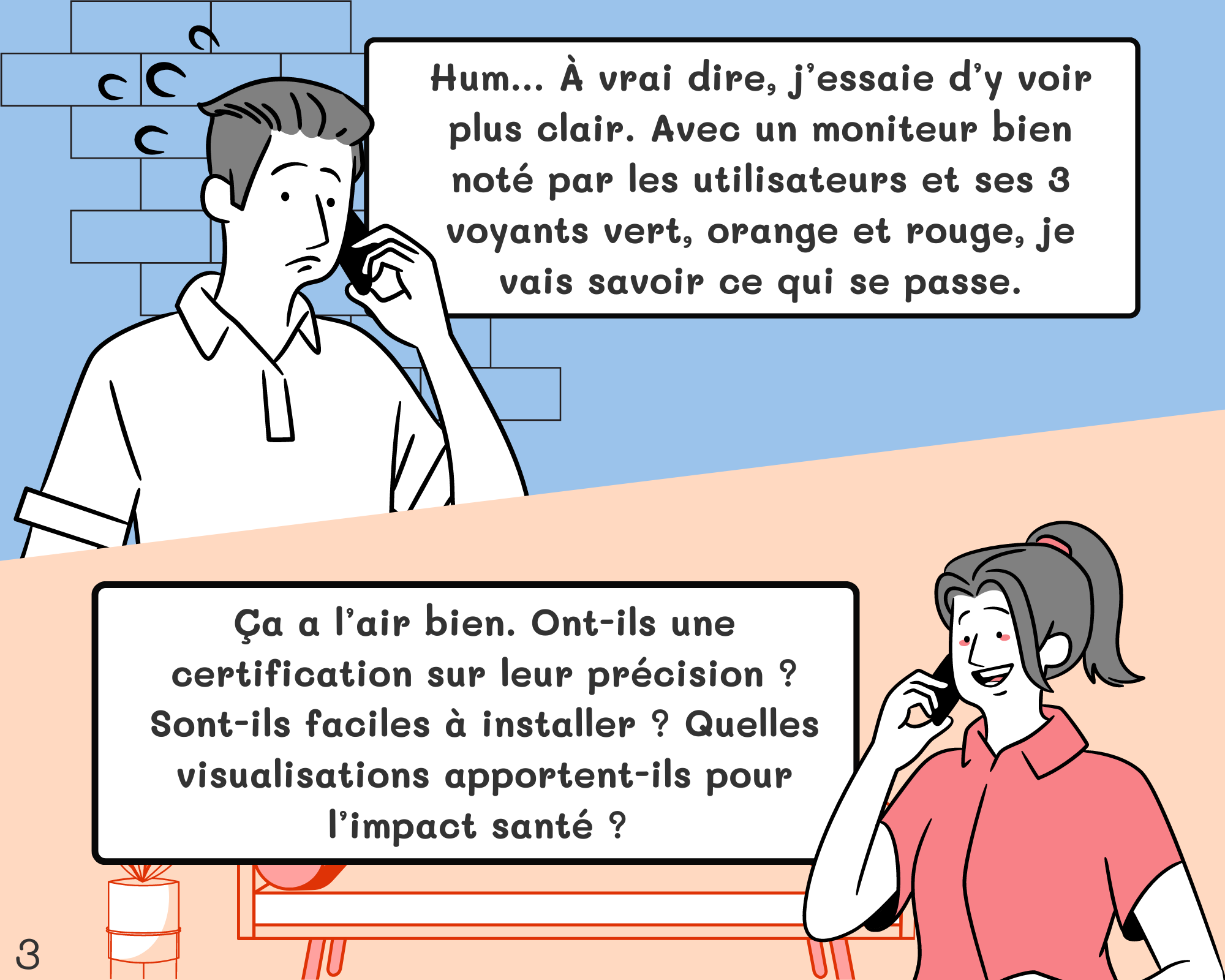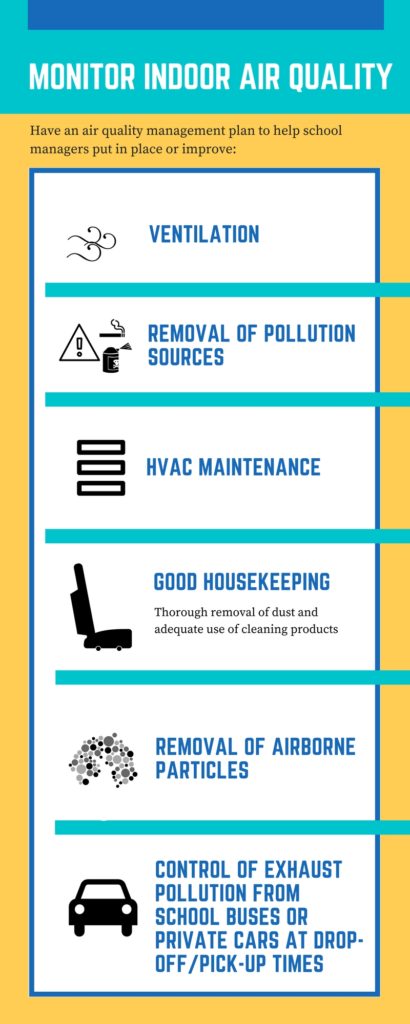



As life is adapting to a new “normal”, schools need to stay open to allow children to build their own identity through learning and social interactions.
Parents, teachers and students will go through tremendous anxiety thinking about the airborne risks that may await them in school. In order to reduce Covid risk in classrooms and any indoor places, it is necessary to check they are not underventilated.
Showing how fast issues were solved…
Meo air analytics newest monitor “mini-meo” will be available from September 2021. It ensures air safety in the premises, with alerts as soon as problems arise, and dedicated advice to remediate. You can then communicate and reassure staff, students and parents on air quality for any time since the installation of the monitors.
“Mini-Meo” is specially designed with dashboards to objectively reduce Covid-related risk:
How to reduce Covid risk?
Covid risk is higher in indoor places where the air is not enough renewed. [link to research]
Virus risk can be reduced with proper ventilation levels. They can be monitored through dedicated KPIs (Key performance Indicators) to adjust BMS (Building Management System) rules to ensure air circulation and appropriate ventilation.
It is easy to install, cyber-secure and the purchase of the monitor includes a 3 year data plan (sim card with data included) with wide access to air analytics!
As some countries start slowly to go back to work in offices, it’s probably time to think about the air we breathe in subways. We have learned so much about indoor air quality throughout this pandemic that we should probably check few things in our local subway system to assess its air quality. From studies conducted few years back we know that in average people spend 30-40 min in metros, time in which they are exposed to harmful air pollutants from components in the subways and from air pollutants that are brought in through the ventilation system.
An assessment from 2017 that looked at more than 160 studies from 20 countries found that airborne bacteria, particulate matter, aromatic hydrocarbons and carbonyls were the main pollutants in all metro systems. It’s estimated that more than 120 million people used the subway every day before the pandemic. In fact, the use of metros have been encouraged as a way to reduce outdoor air pollution, it has always been the smart, efficient and environmentally friendly way to commute.
However, studies have shown that the exposure to air pollution from point A to point B is higher when done in a subway than walking or in trams, but lower than in buses. Studies have also shown that some stations have very poor air quality but others have demonstrated to comply with the European PM2.5 air concentration limits. Suggesting it is possible to have stations with acceptable air quality. It is not clear if the PM prevalent in subways is more toxic than outdoor PM and very little information is out there on the long-term effects of subways’ air quality.
In essence, the source of subway PM comes from the train wheels, brake pads, steel rails and power-supply materials. And is affected by the ventilation, outdoor air supply, depth of station, date of construction, train frequency and the existence of screen-door systems.
Comparison between stations with better air quality and those with poorer air quality shows that changes can be made to improve things. For example, changes in train speed, type of ventilation, the implementation of screen-doors and the use of air purifiers are all positively impacting air quality in subway stations.
If some stations can have acceptable air quality, this means that constant air monitoring can lead to effective changes that will benefit those millions of subway users.
Open Edition Journals- Commuting by subway? What you need to know about air quality
Science Direct- Air quality inside subway metro indoor environment worldwide: A review.
Productivity across all levels of employment matters and business leaders struggle to make sure it is optimized by investing in training, team building, office settings, freebies and many other proven strategies. However, 15 years of research has shown a close link between air quality and productivity that are the basis for green buildings and better indoor air management.
For many years we have known about the sick building syndrome (SBS), which are the common ailments that arise from time spent in a particular building and being exposed to poor ventilation or air filtration, outgasses from building materials, volatile organic compounds (VOC) and molds. Common ailments resulting from SBS are: headache, dizziness, nausea, eye, nose or throat irritation, dry cough, itchy skin, poor concentration, fatigue, voice hoarseness, allergies, cold, increased asthma and flu-like symptoms. And it all escalates to affect our congnitive capacity and productivity. So efforts to reduce both indoor and outdoor air pollution are actually investments in productivity, human capital and economic development.
The earliest known research on air quality and productivity dates back to 1999. Since then many studies on packers, call centers, farmers and even football players have confirmed that poor air quality has a negative effect on productivity, both indoors and outdoors.



In 2011, the National Bureau of Economic Research looked at farm workers output and ozone levels. They found that a decrease of 10ppb in Ozone concentrations increases worker productivity by 4.2%. Overall the research found that even at lower levels of Ozone than the standard, there were negative impacts on productivity and its strict regulation would yield benefits in health, productivity and possibly other areas. This was followed in 2014 by a research at Columbia, the University of South California and the University of California-San Diego where researchers looked into the effect of PM2.5 on pear-packers in California. It was found that just a 10 unit increase in PM2.5 decreased productivity by approximately 6% and that productivity is affected even below US standards. Moreover, Harvard University researchers recently assessed the effect of air quality in knowledge workers, those who are indoors mostly in front of a computer throughout their work day. They analysed Ctrip productivity in China against indoor air quality and found that workers are 5-6% more productive when air pollution is 0-50 AQI compared to 150-200 AQI. In a separate research by Harvard and Syracuse University, researchers looked into VOCs, CO2 and productivity. In addition to confirming the negative effect of air pollution on cognitive function, they specifically found that the greatest change (up to 15%) was observed in those cognitive functions involved in crisis response, information usage and strategy.
This body of research has shown how important it is to look into ways to improve indoor air quality. John Mandyck, chief sustainability officer for the NYSE listed United Technologies Corporation (UTC) said:

So what can we do with all those buildings that are old or just not green?
Let’s:
Sources:
NIH – The Sick Building Syndrome
Harvard Business Review – Air Pollution is Making Office Workers Less Productive
INSIDER – The pollution outside your office window affects your work.
EPA – An Office Building Occupants Guide to Indoor Air Quality
The World – Want better thinking and productivity? Improve the air quality in your office.
Around the world the pandemic has taken many forms. Some are working from home while others have to work in their offices. Although offices may have less people to ensure social distancing, managers and office space administrators should still take crucial steps to protect their staff. The past months of increased information about how COVID-19 spreads silently, has opened our eyes about the relevance of clean air and social practices in protecting us.
Although, outdoors is the ideal place to gather for safety purposes, offices, and shops can also minimize risk and have employees back in business with their safety as their first priority.
The following steps require to re-think the office with airflow safety in mind. We need to re-think the way we use office space and even office supplies. Understanding that clean air and clean surfaces are the ultimate goal to staff safety. A new type of health and safety plan is required focusing on: 1) infrastructure maintenance, 2) re-thinking the way we use the space, and 3) ensuring all staff members are involved in the process and understand the need for a change in the way we work and the way we safely socialize.
Start by analyzing the infrastructure and how your devices can ensure the air in the premises is safe. The Heating, Ventilation and Air Conditioning (HVAC) system needs to have the appropriate filters and they should be maintained regularly. Preferably HEPA filters should be used. If possible, outdoor air circulation should be increased; and airflow supply should be re-examined. Similarly, exhaust fans in restrooms are to be checked for performance and encourage their use at all times. This should be coupled with enhancing cleaning and disinfection at all times. Have a close look at the quality of the indoor air, it will make a difference.
Then move to conduct a hazard assessment with the COVID-19 thinking cap. Identifying areas where COVID 19 transmission could happen and how to change them. For example, the meeting rooms, cafeteria, break rooms, waiting areas and many more. This will result in necessary modifications of workstation distancing, or the use of shields to physically separate employees in all areas. And, wherever physical barriers are not possible, visual cues on the floor can help employees distance themselves. Even shifts staggering will be crucial. Also, re-think best options for high-touch communal items such as coffee pot, microwave etc.
Last but not least, develop a communication plan to adequately convey health safety messages and changes in space usage to employees. Set a protocol for employees to know when to stay home, how to work from home when they have symptoms, or when a family member has symptoms. And if possible, provide that flexibility to work from home. Use signage to remind people of key actions to reduce transmission.
Keep in mind, indoor air quality is key to employees’ health and safety!
How often do we think about the air quality in our children’s school, where they spend almost a third of their day?
In cities with poor outdoor air quality, schools usually limit outdoor physical education and break time according to local outdoor air quality readings. But what about the quality of the indoor air?
Studies have shown that poor air quality in schools increase absenteeism, decrease test scores and compromise staff and student productivity.
When we think of academic excellence we’ll seldom think of structural and maintenance practices that can provide the optimal environment for teachers and students to thrive. Nonetheless, leaky roofs, poor heating, ventilating and air conditioning systems (HVAC), inappropriate use of cleaning products among others can make a difference in academic excellence.
In fact, poor indoor air quality can cause asthma, respiratory infections and allergic diseases which start a spiral of effects from school absenteeism to poor performance.
Asthma, respiratory infections and allergic diseases are commonly caused or exacerbated by moisture in HVAC system, microbiological pollutants, animal allergens, nitrogen dioxide or other combustion byproducts, chemicals in cleaning products, low ventilation, formaldehyde, dampness, mold, outdoor pollutants or vehicle exhaust.
Asthma for example is suffered by millions across the world – approximately 1 in every 10 children! And it is the main reason students skip school in the US. Asthma can be controlled with medications after it occurs but a great deal can be done before it occurs by controlling the environmental triggers, especially in closed environments like schools.

Sources:
US EPA (United States Environmental Protection Agency) – Printable Version of the Coordinator’s Guide for Indoor Air Quality
US EPA (United States Environmental Protection Agency) – Indoor Air Quality in High Performance Schools
US EPA (United States Environmental Protection Agency) – Managing Asthma in the School Environment
The World Health Organisation estimates that 3.7 million deaths are the result of outdoor air pollution, and 4.3 million deaths are attributable to indoor air pollution. Sadly, our region (Western Pacific) has the highest number of casualties due to air pollution.
Air pollution control is not entirely in the hands of individuals, but controlling exposure to air pollution is.
Follow these WHO links for additional information: